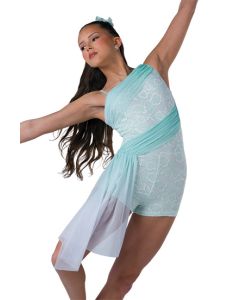Lyrical Dance Costumes: The Art of Wearing Emotion on Stage

Dance is not only about movement; it is about telling a story that words cannot capture. Lyrical dance, in particular, bridges the elegance of ballet with the expressive freedom of contemporary styles. Every leap, turn, and extension carries emotion. But what often completes that story is the costume. Lyrical dance costumes are more than stage outfits—they are an extension of the dancer’s emotions, helping the audience feel the story with every step.
Why Costumes Matter in Lyrical Dance
In hip-hop, costumes may emphasize boldness, while in jazz, they often sparkle with sequins. Lyrical dance, however, thrives on subtlety. The costumes are designed to flow with the dancer’s body, accentuating movement rather than distracting from it. A well-chosen costume doesn’t just look beautiful; it transforms the dancer into a living canvas of emotion.
For instance, a soft chiffon dress can visually translate vulnerability, while deeper shades of velvet or mesh can embody grief or inner conflict. The right costume deepens the connection between the choreography, the music, and the audience.
Defining Features of Lyrical Dance Costumes
When you look at costumes in lyrical performances, certain characteristics stand out:
- Fluid Fabrics
Materials like chiffon, mesh, or silk are commonly used because they create flowing visuals with each movement. The fabric almost becomes part of the choreography. - Unrestricted Movement
Since lyrical routines involve splits, floor rolls, and high extensions, costumes are designed for maximum flexibility and comfort. Stretch fabrics and breathable designs are essentials. - Simplicity Over Sparkle
Lyrical costumes usually avoid heavy sequins, rhinestones, or structured designs. The minimalism ensures that nothing distracts from the story being told. - Barefoot Compatibility
Most lyrical dancers perform barefoot, so costumes are styled to look natural without the need for footwear accents.
The Role of Color in Expression
Colors in lyrical dance costumes aren’t chosen randomly—they carry emotional weight.
- White, cream, or pale blue: Often used to represent innocence, purity, or hope.
- Shades of red or burgundy: Signify passion, heartbreak, or love.
- Dark tones like black, navy, or deep purple: Reflect sorrow, struggle, or inner strength.
- Pastels: Create a soft, dreamlike effect, perfect for routines based on serenity or reflection.
Through color alone, a dancer can set the emotional tone before the first step is even taken.
Modern Trends in Lyrical Dance Costumes
While tradition favors flowing dresses, modern designers and choreographers are experimenting with fresh styles to keep performances visually unique. Some popular trends include:
- Asymmetrical designs: One-shoulder straps, uneven hems, or cut-outs that create an abstract look.
- Sheer overlays: Light layers of mesh or chiffon that float with movement, adding depth to the costume.
- Two-piece sets: Crop tops paired with high-waisted skirts or shorts—offering a contemporary twist while preserving lyrical softness.
- Custom tailoring: Dance studios increasingly commission bespoke costumes that match the choreography’s exact theme.
How to Choose the Perfect Lyrical Costume
Picking the right costume is as important as choosing the choreography. Here are a few tips:
- Prioritize comfort: A costume should feel like a second skin, not a distraction.
- Match the theme: The costume should visually echo the story and music.
- Consider fabric flow: Avoid heavy or stiff fabrics that don’t move naturally.
- Keep accessories minimal: Jewelry or heavy embellishments can break the emotional focus.
Beyond Aesthetics: Costumes as Storytelling Tools
A lyrical dance performance is meant to touch the audience on an emotional level. Costumes, therefore, act as silent storytellers. Imagine a routine about resilience—the dancer, dressed in deep shades of blue with flowing layers, rising again and again after every fall. The costume enhances the narrative, making the story unforgettable.
When chosen with intention, lyrical dance costumes do more than decorate a dancer; they amplify the meaning behind each movement.
Final Thoughts
Lyrical dance is the language of emotions, and costumes are the words that help complete the sentence. They are subtle, flowing, and expressive—just like the style itself. A dancer’s story is not only told through choreography but also through what they wear on stage. That is why lyrical dance costumes hold such power: they turn every performance into a poetic blend of movement, fabric, and feeling.
